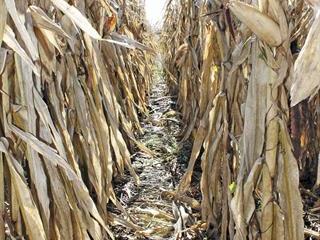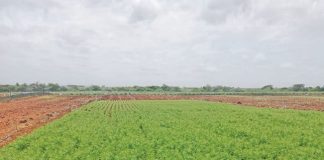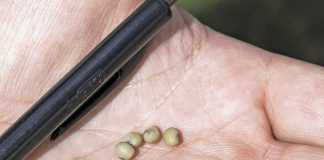
In 2010, Dr Philip Theunissen made the decision to plant crops on his 153ha farm near Bethlehem in the Free State, so he ordered what he thought was a conventional tillage planter. To his surprise, the Jumil planter arrived with an additional crate of no-till accessories. Storing this crate on his farm, Philip planted his crops conventionally.
“During my first summer crops season, it took me almost eight days to plough, disc and plant 22ha of soya beans. Being a part-time farmer, I had to do all this work myself. I quickly grew frustrated at the fact that getting this crop into the ground was taking me so long and keeping me away from my other work,” he says.
The following summer, Philip decided to see if fitting the no-till accessories to his planter would speed up the planting process. With no additional preparation, he began planting his crop lands as soon as these accessories were fitted to the implement.
“I didn’t really know what I was doing,” he admits. “All I wanted to find out was if planting using no-till technology and practices would save me time. To my great surprise, it took me only two days to get 22ha of soya beans planted, and my soya beans yielded almost exactly the same as the conventionally planted crop of the previous summer!”
Intrigued by these results, Philip determined to find out more about the cost, efficiency and investment return differences between growing crops using conventional tillage practices and using no-till practices. Being an agricultural economist as well as a part-time farmer, he was especially interested in obtaining answers.
Trial Crops
By lucky concidence, one of Philip’s clients in the Free State’s Reitz district was planning to plant trial plots on his own farm to carry out a similar comparison on maize. Philip asked him to record all the details of these trials and volunteered to do an in-depth analysis of the results, working with his son, Ruhan, a mechanical engineer and also a part-time farmer. The farmer agreed and went to work.
Several months later, the Theunissens had the data they needed and used it to produce a financial comparison of conventional tillage and no-till maize crops.
“The trial plots were next to each other, and the soil type, rainfall, temperatures, and other aspects were exactly the same. This was during the 2013/2014 summer production season,” Philip explains.
Cost Similarities
Several costs remained the same for both the no-till and the conventional tillage maize production trials:
- Seed costs: R1 254/ha
- Fertiliser costs: R1 918/ha
- Pest control: R37/ha
- Crop insurance for 5t/ ha: R271/ha
- Harvest costs: R463/ha
- Transport costs for the maize harvest: R342/ha
Cost Differences
Listed below are the cost differences between producing no-till and conventional tillage maize. The differences calculated either indicate that the no-till production cost more (indicated by a ‘-,’ thereby showing a loss of x), or cost less (indicated by a ‘+,’ thereby showing a gain of x) in a particular production area.
Weed control:
No-till: R1 077/ ha
Tillage: R858/ha
Difference: -R219/ha
Overall machinery costs
No-till: R900/ha, with a fuel cost of R252/ha, depreciation and repairs cost of R630/ ha and operator costs of R18/ha;
Tillage: R1 538/ ha, with a fuel cost of R550/ha, depreciation and repairs cost of R962/ha and operator costs of R26/ha;
Difference: +R638/ha, with a fuel cost difference of +R298/ha, depreciation and repair cost difference of +R332/ha and an operator cost difference of +R8/ha.
Total yield
No-till: 7,5t/ha
Tillage: 6,9t/ha
Difference: +0,6t/ha
Production efficiencies
Philip and Ruhan found that no-till maize production was more fuel- and labour-efficient than tillage maize production.
“To produce the 7,5t/ha average yield of no-till maize required 2,8l diesel/t, and 12 minutes labour per ton. To produce the 6,9t/ ha average yield of conventional tillage maize required 6,7l diesel/t and 19 minutes labour per ton,” Philip explains.
Thus the overall diesel volume and labour requirements were as follows:
Diesel volume used
No-till: 21l/ha
Tillage: 45,9l/ha
Difference: +24,9l/ha
Labour hours
No-till: 1,53h/ha (113 min/ha)
Tillage: 2,23h/ha (143 min/ha)
Difference: +30 min/ha
Gross Income
The 2013/2014 season’s maize price was R1 750/t. Thus, gross incomes generated, calculated as yield (in tons) multiplied by maize price per ton, were:
No-till: R13 125/ha
Tillage: R12 075/ha
Difference: +R1 050/ ha (This is 8,7%/ha more than the income generated by the tillage crop).
“Taking into account all of the production expenses versus the gross income, the no-till maize generated a net profit of R6 650/ha, which was R1 459/ ha more than the conventional tillage maize’s net profit of R5 191/ha,” Philip explains.
Return on investment
Finally, Philip and Ruhan compared the return on investment (ROI) between the no-till maize and the conventional tillage maize in the trials. This required them to extrapolate comparisons up to 250ha each of these maize production systems to generate meaningful figures.
Machinery investment
No-till: R5 968/ ha
Tillage: R11 650/ha
The land price was calculated at R15 000/ha and the total land and machinery investment therefore amounted to:
No-till: R20 968/ha
Tillage: R26 650/ha
Difference: +R5 682
“Based on all of the production costs in the trials against the net profits, the ROI for the no-till maize was 32%, in comparison with the 19% ROI for the conventional tillage maize,” says Philip.
In sum, therefore, the ROI of no-till maize was 13% higher than that of conventional tillage.
Learning from the analysis
Philip says that if he had possessed these comparisons before he started crop farming, he would have immediately adopted the no-till production methods. Not only did the no-till maize produce a higher gross income, it was generally more cost- and labour-efficient than the conventional tillage maize crop.
“I would, however, have first planted a cover crop on the lands I was planning on planting to summer grains. This would have provided the start to the important organic soil cover that no-till requires. On this, I would have planted my first crop,” Philip says.
Email Philip at [email protected]. This presentation was given at the No-Till Club’s No-Till Conservation Agriculture Information Day in Hilton, KwaZulu-Natal, on 21 April 2016.













